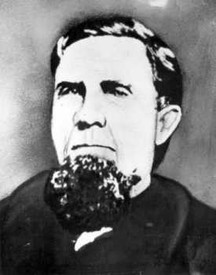Southwood Community
Introduction
Text-to-speech Audio
Images
George T. Ward

Backstory and Context
Text-to-speech Audio
George Taliafero Ward arrived in Tallahassee in 1825 with his family. That same year he went to work in the Land Office where his father worked with Richard Keith Call. As a young man, Ward rose to prominence in Tallahassee. He served on the Florida Territorial Council in 1837-1838 and was elected as a convention delegate to the Florida constitution convention held in St. Joseph in 1838. He was also one of the first officers of Union Bank in Tallahassee when it was founded. Ward continued to dabble in politics when he later ran for governor in 1852 as a Whig losing to Democrat William Moseley. All of this, of course, was in addition to his primary role of planter in Leon County.
Ward inherited Southwood from his father and in 1844 increased his lands when he married Sarah Jane Chaires, widow of Benjamin Chaires, part of the wealthy Chaires family in Leon County. A large part of the land she inherited from the death of Benjamin was incorporated into Ward’s land to make Southwood even larger. Between Southwood and the other two plantations Ward possessed, he owned at least 160 slaves, produced a 500-plus bale cotton crop, and a 7,500 bushel corn crop by 1859.
Politics and planting were not the only things George Ward participated in around Tallahassee. He also took part in a duel with local militia leader Augustus Alston. Ward blamed Alton for the death of his brother, William Ward, during a battle with Native Americans. Alston had apparently given an order that resulted in William’s death. Allegedly, Ward confronted Alston by slapping him in the face with a riding crop and Alton made the challenge into a duel. They met at an area often used for duels in Leon County, likely near Lake Lafayette. Alston fired first hitting Ward in the leg and wounding him seriously. Alston advance firing again hitting Ward in the arm. This left Alston out of ammunition, giving Ward an open kill shot. However, Ward then managed to miss.. Ward allegedly wanted to continue the duel with other weapons, but he passed out from his injuries before further action could occur.
As the Civil War drew close, George Ward served as a delegate to the Secession Convention in Montgomery, AL. Ward would later go on to command the Second Florida Infantry Regiment of the Confederate Army. During the Battle of Williamsburg, Colonel Ward took his regiment on a countercharge against advancing Union troops in order to recover a retreat by units commanded by General Joseph Johnston. During the charge, Ward was shot, apparently through the heart according to one witness, and fell dead on May 5, 1862. Soldiers of his command later retrieved his body and buried him in Williamsburg, VA.
Sources
1.Baptist, Edward. Creating an Old South: Middle Florida’s Plantation Frontier Before the Civil War. Chapel Hill, NC: The University of North Carolina Press, 2002.
2.George T. Ward Secession Broadside, Special Collections, Robert Manning Strozier Library, Florida State University, Tallahassee, Florida
3.Groene Bertram, Ante-Bellum Tallahassee. Tallahassee, FL: Florida Heritage Foundation, 1971, http://ufdc.ufl.edu/FS00000017/00001/39j.
4.Paisley, Clifton. From Cotton to Quail: An Agricultural Chronicle of Leon County, Florida 1860-1967. 3rd Printing, Tallahassee, FL: University Presses of Florida, 1991
5.Paisley, Clifton. The Red Hills of Florida: 1528-1865. Tuscaloosa, AL: The University of Alabama Press, 1989.
By State Library and Archives of Florida - https://www.floridamemory.com/items/show/28085, Public Domain, https://commons.wikimedia.org/w/index.php?curid=58270104
